
15 tips and sourcing strategies in recruitment

Creative sourcing strategies in recruitment are vital. Attracting top talent is essential to the future of your organization. To fill future positions and get ahead of your competition, you need to find the best candidates. For this, you need to implement the best recruitment strategies.
Candidate sourcing is the means of identifying candidates for a job opening. A proactive approach to candidate recruitment. Potential candidates fall into two main categories, active candidates—active job seekers seeking employment; and passive candidates—who might be tempted by a new position but aren’t actively searching. A good hiring manager will have a recruiting process that looks to source candidates from various different areas.
1. Know the difference: sourcing vs recruiting
The duties for both sourcing and recruiting should be clearly defined. If your organization has the capacity, it can be better to divide the positions, allowing for greater accountability for each role.
Candidate sourcing is the process of searching for, identifying, and contacting quality candidates who could be a great fit for your company. If you look to source top talent, you will generally end up with the best employees, so this part of the discovery phase is crucial. To give you an idea of how crucial, one in every 72 sourced candidates is hired, compared to one in every 152 non-sourced candidates.
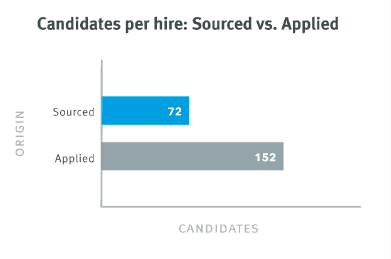
Image credit: Lever Recruiting Benchmarks Report
The key responsibilities of hiring managers during candidate sourcing are to :
- Collect valuable candidate information, like resumes and work samples, as well as the type of projects candidates typically work on (check GitHub and Stack Overflow)
- Pre-screen candidates with skills that match the roles they’re recruiting for
- Contact candidates to build relationships and inform them about job openings
- Build long-term relationships with potential hires
Typically, those who source candidates are tasked at the beginning of the talent-sourcing process to find, qualify, and contact new potential hires. The process of recruiting kicks in after and includes the HR duties of screening, interviewing, and evaluating applicants.
2. Plan long-term sourcing strategies in recruitment
Creating and implementing a long-term plan for candidate sourcing as a part of a broader recruitment plan is a key detail. The best candidate sourcing strategies begin with a clear and sustainable recruitment process.
A few pointers on where to start:
2.1) Goal identification – It’s worth knowing what your company wants to achieve and when/how it plans to do so.
2.2) Establish specific sourcing and recruitment needs – Be sure to carefully define your strategy in a way that clearly sets out what is needed. One way to do this is competency mapping or skill mapping your organization. Present this to management early.
2.3) Define your target candidates – Identifying specific skill sets, personas, behaviors or academic backgrounds can help build a desired candidate profile before the position goes live.
2.4) Know how and where to source – What networks can be exploited? What is the best way to approach candidates? Knowing this will help you pinpoint the most qualified talent.
2.5) Set checkpoints for review – Setting checkpoints (based on dates or events) can be constructive for your team to see what metrics can be measured to determine the effectiveness of your candidate sourcing strategy.
3. Build a strong employer brand to attract strong candidates
Reviewing and shaping your employer brand is crucial. A company with a negative brand, or without a solid reputation, will struggle to attract the right candidate. Employer branding can consist of various elements and is incredibly important for shaping how people view your company.
A strong employer brand is an incredibly effective recruiting tool. Ninety-two percent of candidates say they would consider leaving their job if a company with an excellent corporate reputation offered them another role.
Some quick points on helping to build or repair your employer brand include:
3.1) Respond to reviews – Sixty-one percent of candidates check company reviews and ratings before they determine their interest in a job.
3.2) Tell your story – Engage your employees in storytelling and provide a platform for them to share their positive experiences about your company.
3.3) Partner with marketing – The marketing teams creative skills and distribution ideas can help take the brand to the next level.
Get these basics right, to make sure your employer branding is on-point.
Image credit: Glassdoor Top HR Statistics
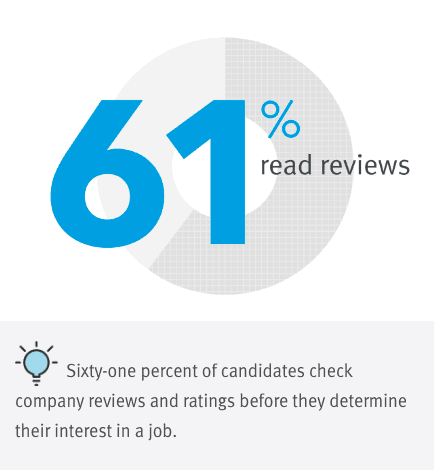
4. Know the role you’re hiring for
Familiarize yourself with the role as if you’re looking for the job yourself. How can recruiting teams write an accurate job description if they don’t know what the job entails? Here is a glossary of terms you can use to get yourself acquainted with the technical aspects of the position.
Doing some research and speaking to other members in similar roles will help you find candidates that match your needs. Wrapping your head around what is expected is essential to make sure your job description is realistic and not a ‘wish list’. Having a chat with the hiring manager about the standards of the role is the next rung of the ladder.
A clever recruiting tactic by Google, used to source engineers – Recruitainment Blog

5. Be in sync with the hiring manager
Collaborate with hiring managers early and often to ensure you’re on the same page about what the ideal candidate will be.
You might find a qualified candidate whose experience is not on the same level as what you’re after, but their skills and qualifications mean they could step into the role. Sometimes finding strong candidates is more realistic than perfect candidates. This process can broaden the spectrum of candidates you’re willing to consider. Distinguishing between ‘must-have’ and ‘nice-to-have ‘ skills is an important factor here. According to LinkedIn, removing or altering two job criteria increases the talent pool by over 6 times.
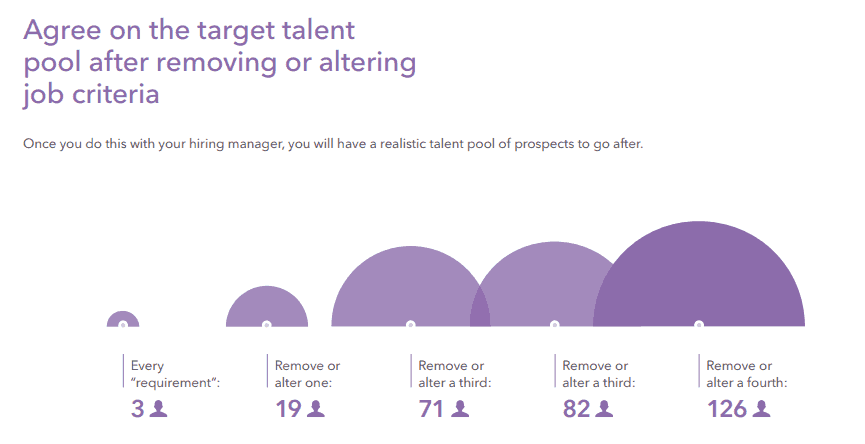
Image source: LinkedIn
Regularly reviewing the overall talent pool can help determine whether measures need to be tightened or relaxed to choose from the right number of candidates.
When working closely with hiring managers, you should understand their priorities and the trends affecting their work. According to hiring managers worldwide, the top trends to shape the recruitment industry in the next few years are recruiting more diverse candidates (37%), soft skills assessment (35%), innovative interviewing tools (34%), company mission as a differentiator (33%), and using big data (29%).
6. Establish a referral program
Employee referrals have long been a staple method of sourcing potential candidates.
Seventy-eight percent of recruiters say they’ve found their best candidates via referrals.
All employees in your company have their own network of former colleagues and personal and professional connections. Many of whom, could be potential candidates.
A more passive candidate might hesitate to respond to a recruitment message, but are more likely to consider an opportunity brought to them by a personal connection.
An employee referral program won’t just help you find more candidates — they’re proven to lead to more qualified candidates. Studies show that referred employees perform up to fifteen percent betterthan non-referred hires.
Image credit: Jobvite Recruiter Nation Survey

Image credit: Jobvite Recruiter Nation Survey
7. Perfect the outreach message
Another important recruitment sourcing strategy is concocting the perfect outreach message. All your hard work sourcing candidates is wasted without the right introductory message.
A few rules to aid your message:
7.1) Lead with a unique subject line that will make new candidates want to open and read your message.
7.2) Always personalize your message with the relevant information you found about them.
7.3) Paint a brief picture of the role and your organization.
7.4) Explain how you think they could contribute to the team.
8. Source from your ATS first
Almost all companies (ninety-nine percent) believe re-engaging with candidates will help them build their talent community and protect their employer brand. Still, only fewer than half of employers re-engage declined candidates.
Applicant tracking systems can be very effective when it comes to finding future candidates. You can leverage the work your company has done in the past, by beginning your search with previous candidates already in your ATS. Many times a candidate has already been deemed qualified to work for your organization, meaning you have ready-to-go candidates in the talent pipeline. Providing a great candidate re-engagement experience is imperative here.
It’s worth remembering that talent is four times more likely to consider your company for a future opportunity when you offer them constructive feedback, yet only forty-one per cent of candidates receive feedback.

Image credit: LinkedIn Ultimate List of Hiring Stats
9. Exploit social media
Social media is commonly used in the hiring process of most modern companies. Some effective platforms used for candidate sourcing include LinkedIn, Facebook, Twitter, Meetup and Google+. Many people spend so much time on social media, it is a missed opportunity to exploit this to increase the number of people in your talent pipeline.
10. Diversify potential online sourcing channels
Fifty-two percent of recruiters say they first turn to their professional network to source for their next hire Another twenty-eight percent say they first turn to LinkedIn. It’s true that the trusted methods are the ones that work best. But there’s no need to quit there.
The internet is brimming with possible ways to find the right candidates. For hiring tech talent, sites like GitHub are an ideal place to look for software developers. DeviantArt is one for creatives. Indeed, the job board and resume database can be a crafty option if you’re aiming to be more direct. However, some candidates are more receptive on conventional platforms or websites. Those areas where few others are looking can be great for discovering untapped talent. Try to engage candidates by also posting on less obvious online job boards and forums dedicated to your niche.
Put yourself into the shoes of the ideal candidate and brainstorm what fronts they might be engaged with. Asking your colleagues or researching what they might be interested in can help identify the areas you should be trawling.
Top sourcing channels according to recruiters – Image credit: CV Library Recruiting 2018
 11. Include offline sourcing channels
11. Include offline sourcing channels
Attending industry-specific job fairs can also be a unique way of attracting great potential candidates to your hiring process. Look at job fairs in your city and see if any look like they might aid in your candidate-sourcing efforts.
According to Nice (formerly Mattersight), eighty percent of candidates would take one job over another based on personal relationships formed during the interview process. A candidate is certainly more likely to be receptive to an outreach message once you’ve had a conversation in person.
A great tip is to combine offline and online sourcing, i.e. when looking for conference attendees. You can search Instagram with event-specific hashtags to find people to network with:
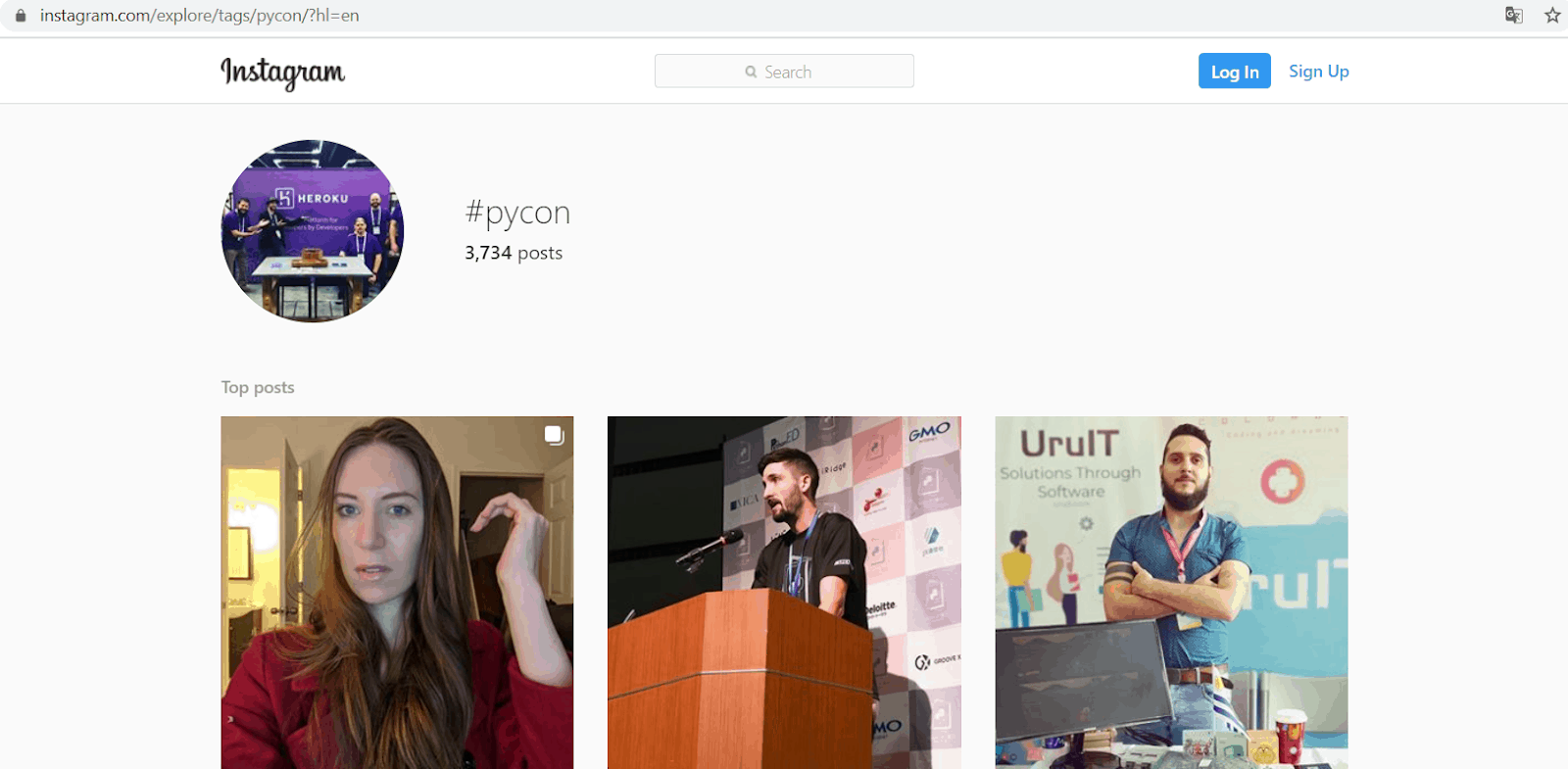
Image source: Instagram
12. Get familiar with Boolean search-engine sourcing
Recruiters customize Boolean searches to scour the web for relevant profiles of niche candidates.
Boolean search is a type of search that combines desired keywords with operators such as AND, NOT and OR to produce relevant results. It’s based on George Boole’s mathematical theory in which all variables are either true or false. You can run Boolean searches on many search engines, including Google.
Familiarizing yourself with Boolean search can be an alternative tactic for candidate sourcing.
13. Source for future (unopen) roles
It pays off to enquire about your employer’s business growth plans within the next two years. A good practice is to research the latest IT skills trends to see where the market is heading.
Establishing roughly when, in what department, and how many extra roles are necessary is vital in planning for your strategy. Once you have an idea where growth is needed, agreeing with your HR hiring manager and finance on the level and skillsets required – you can begin to build your ideal personas for the roles you’re trying to fill.
14. Learn to communicate with passive candidates (and learn to let go)
It’s best not to put all your eggs in one basket when considering passive candidates. Online candidate sourcing channels can be very helpful during your recruitment process for reaching candidates. If candidates are receptive to your outreach procedures then great, but if not, the line between reaching out and pestering is a thin one. One of the biggest selling points of Stack Overflow Jobs is that “Stack Overflow Jobs puts developers first. No recruiter spam or fake job listings.”
Some of the facts we’ve talked about in this post indicate that sourced candidates are more efficient and generally turn out to be top talent. You should carefully gauge their responses, to discover whether there is a potential hire in there somewhere. Or if it’s just a waste of your time.
That said, with most developers being passive candidates, you can’t just give up on reaching out to those who aren’t actively looking for a job. You’d be missing out on the biggest part of the talent pool as over 90% of developers are employed at least part-time. Personalizing your messages and choosing the right way to contact developers is definitely a good idea.

Image source: Stack Overflow
15. Keep track of your sourcing and recruiting metrics
Under the same umbrella as tracking hiring velocity, having an overall measurement schemein place will keep your employment recruitment strategy accountable. Implementing a system for tracking candidate sourcing will help you identify what particular areas need improving. Being able to justify the means to an end is one of our key tips for sourcing strategy in recruitment. Some questions you can use to begin to include:
- Where are the best candidates sourced from?
- What approach to candidate engagement has been most effective in convincing them to apply for a role?
- Which area of the recruitment strategy takes the longest time? Is it abnormal?
- What is your Time to Fill and Time to Hire?
- How many contact attempts does it normally take to garner a candidate response?
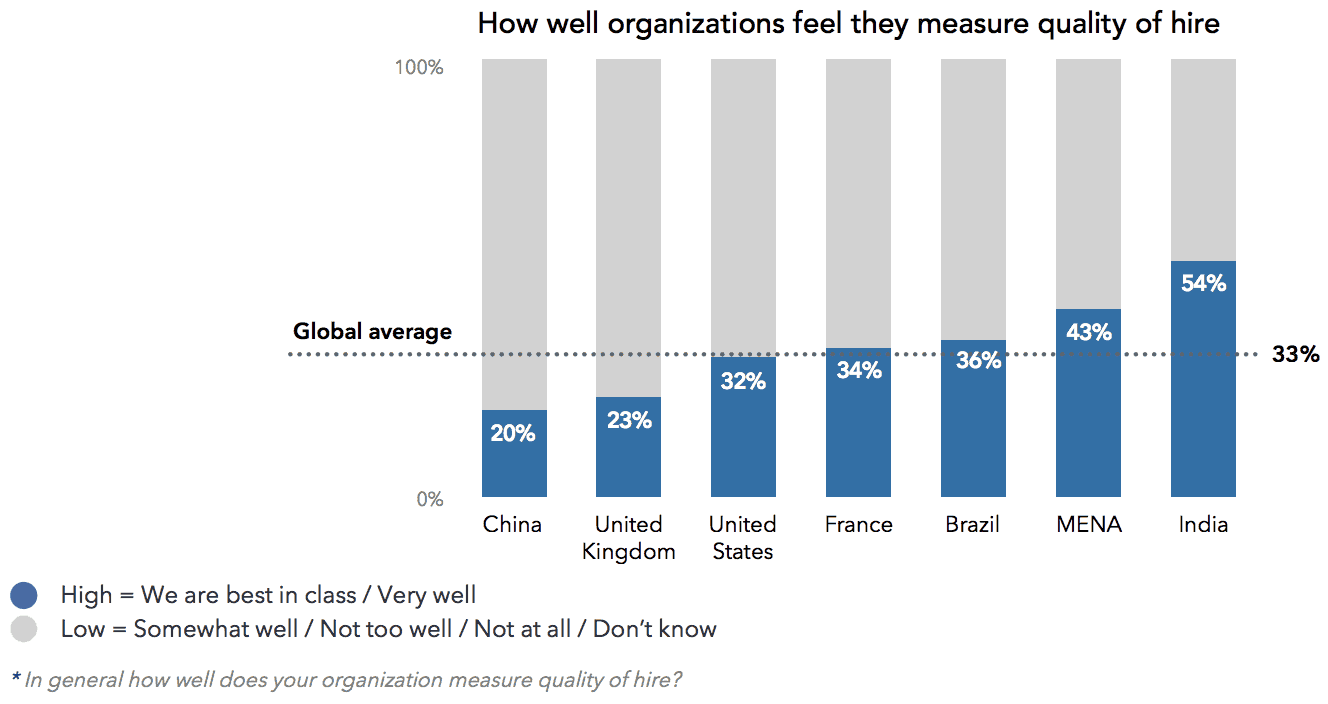
Image credit: LinkedIn
Closing thoughts
What’s true is that an employee recruitment strategy is only as good as the most recent person hired. Being on top of your metrics will be one of the most effective tools for any person involved in recruitment going forward.
Sourcing talent is possible from a variety of diverse areas and no plan is ever perfect. You will find some employers prefer the instantaneous, quantity driven online approach, and others prefer a direct, more personable and loyalty based tactic. Regardless of where you find yourself, embrace the possibilities around you and leave no stone unturned.
Keep these 15 sourcing strategies handy and show it to your colleagues if they need a helping hand.

Image credit: ApplicantStack
Image creadit: John Schnobrich on Unsplash




